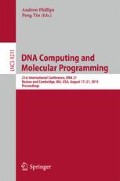Abstract
Working in a three-dimensional variant of Winfree’s abstract Tile Assembly Model, we show that, for all \(N \in \mathbb {N}\), there is a tile set that uniquely self-assembles into an \(N \times N\) square shape at temperature 1 with optimal program-size complexity of \(O(\log N / \log \log N)\) (the program-size complexity, also known as tile complexity, of a shape is the minimum number of unique tile types required to uniquely self-assemble it). Moreover, our construction is “just barely” 3D in the sense that it works even when the placement of tiles is restricted to the \(z = 0\) and \(z = 1\) planes. This result affirmatively answers an open question from Cook, Fu, Schweller (SODA 2011). To achieve this result, we develop a general 3D temperature 1 optimal encoding construction, reminiscent of the 2D temperature 2 optimal encoding construction of Soloveichik and Winfree (SICOMP 2007), and perhaps of independent interest.
Access this chapter
Tax calculation will be finalised at checkout
Purchases are for personal use only
Notes
- 1.
Technically, Rothemund and Winfree established the 2D self-assembly case, but their proof easily generalizes to 3D self-assembly.
- 2.
One subtle difference between our 3D definition of K and the original 2D definition of the tile complexity of an \(N \times N\) square, given by Rothemund and Winfree in [7], is that they assume a fully-connected final structure, whereas we do not.
References
Adleman, L., Cheng, Q., Goel, A., Huang, M.D.: Running time and program size for self-assembled squares. In: STOC, Huang, pp. 740–748 (2001)
Cook, M., Fu, Y., Schweller, R.: Temperature 1 self-assembly: deterministic assembly in 3D and probabilistic assembly in 2D. In: SODA 2011: Proceedings of the 22nd Annual ACM-SIAM Symposium on Discrete Algorithms. SIAM (2011)
Doty, D., Patitz, M.J., Summers, S.M.: Limitations of self-assembly at temperature 1. Theor. Comput. Sci. 412, 145–158 (2011)
Li, M., Vitányi, P.: An Introduction to Kolmogorov Complexity and its Applications, 3rd edn. Springer, New York (2008)
Manuch, J., Stacho, L., Stoll, C.: Two lower bounds for self-assemblies at temperature 1. J. Comput. Biol. 17(6), 841–852 (2010)
Presburger, Mojżesz: Über die vollständigkeit eines gewissen systems der arithmetik ganzer zahlen, welchem die addition als einzige operation hervortritt. In: Compte-Rendus du Premier Congrès des Mathématiciens des Pays Slaves, Warsaw, pp. 92–101 (1930)
Rothemund, P. W., Winfree, E.: The program-size complexity of self-assembled squares (extended abstract). In: STOC 2000: Proceedings of the Thirty-second Annual ACM Symposium on Theory of Computing, pp. 459–468 (2000)
Soloveichik, D., Winfree, E.: Complexity of self-assembled shapes. SIAM J. Comput. 36(6), 1544–1569 (2007)
Wang, H.: Proving theorems by pattern recognition - II. Bell Syst. Tech. J. XL 40(1), 1–41 (1961)
Winfree, E.: Algorithmic self-assembly of DNA. Ph.D. thesis, California Institute of Technology, June 1998
Author information
Authors and Affiliations
Corresponding author
Editor information
Editors and Affiliations
Rights and permissions
Copyright information
© 2015 Springer International Publishing Switzerland
About this paper
Cite this paper
Furcy, D., Micka, S., Summers, S.M. (2015). Optimal Program-Size Complexity for Self-Assembly at Temperature 1 in 3D. In: Phillips, A., Yin, P. (eds) DNA Computing and Molecular Programming. DNA 2015. Lecture Notes in Computer Science(), vol 9211. Springer, Cham. https://doi.org/10.1007/978-3-319-21999-8_5
Download citation
DOI: https://doi.org/10.1007/978-3-319-21999-8_5
Published:
Publisher Name: Springer, Cham
Print ISBN: 978-3-319-21998-1
Online ISBN: 978-3-319-21999-8
eBook Packages: Computer ScienceComputer Science (R0)

